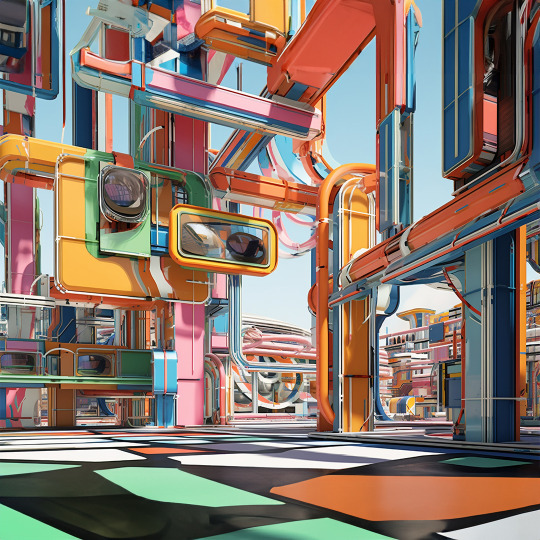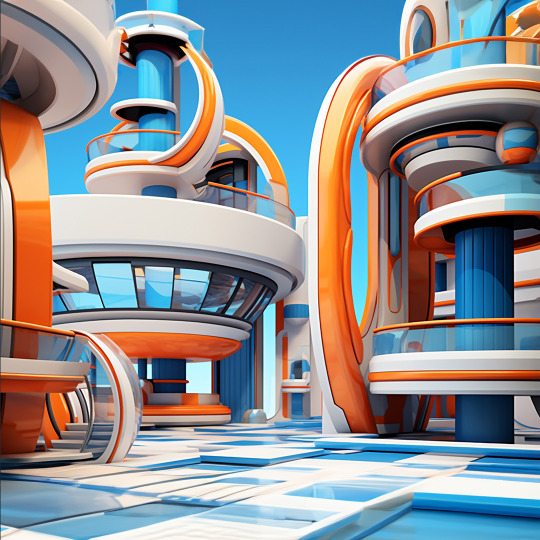#architecturalexploration
Text

Unlocking Architectural Dimensions: The Magic Angle's Influence
In the realm of architecture, the magic angle transcends its scientific roots to become a catalyst for spatial exploration and conceptual innovation. Defined at approximately 54.7356°, this angle, symbolized by θm, holds profound implications not only in nuclear magnetic resonance but also in architectural representation and built form.
At its core, the magic angle intersects with the concept of the fourth dimension, a realm where time and space intertwine in infinite possibilities. In architectural representation, particularly in isometric drawing, the magic angle serves as a gateway to depict three-dimensional forms on a two-dimensional plane. By aligning coordinates at 120-degree angles, architects create visual constructions that hint at the elusive fourth dimension, albeit with inherent visual limitations.
Beyond representation, the magic angle finds practical application in built architecture's geometry. From the subtle play of roof pitch angles in structures like the Moorfield's Tabernacle in Shoreditch to the avant-garde designs of conceptual models like House X by Peter Eisenman, architects leverage θm to imbue spaces with a sense of dynamism and intrigue. By manipulating geometric relationships, they evoke a heightened spatial experience that challenges conventional perceptions of form and dimensionality.
Yet, the magic angle's significance extends beyond its mathematical precision. Its association with Scientology's mythology of Thetans adds a layer of mystique, suggesting a convergence of scientific inquiry and spiritual exploration. As Thetans are described as immortal spiritual beings, the resonance with nuclear magnetic resonance underscores architecture's capacity to evoke transcendental experiences beyond the physical realm.
In essence, the magic angle represents a convergence of scientific inquiry, artistic expression, and philosophical contemplation within architectural discourse. It invites architects to push the boundaries of spatial representation and design, unlocking new dimensions of perception and imagination. As θm continues to shape architectural practice, it serves as a testament to the enduring quest for innovation and enlightenment in the built environment.
#MagicAngleArchitecture#ArchitecturalInnovation#FourthDimensionDesign#SpatialRepresentation#ArchitecturalExploration#ThetanMythology#ScientologyArchitecture#SpatialImagination#TranscendentalDesign#architecturaldimensions#architecture#berlin#area#london#acme#chicago#puzzle#edwin lutyens#massimoscolari#oma
0 notes
Text
🌐✨Embarking on the Odyssey of Innovative Architecture!✨🏗️
Hello, everyone! Today, let's delve into the dynamic world of architectural progress—steel-framed spatial concepts! 💡🏢
In the realm of construction, steel-framed spatial concepts are asserting themselves as visionaries in contemporary architecture, injecting structures with unparalleled creativity and state-of-the-art technology. 🚀💼
💪What Distinguishes Steel Structures?
Beyond their inherent strength and enduring resilience, steel structures showcase exceptional seismic performance, ensuring heightened safety for our architectural masterpieces. 😌🏠
🌐Explore a reputable provider of steel structures: Safe Steel Structure. 🌐
🏗️Defining Features of Safe Steel Structure:
💼Proficient Team: A seasoned and dedicated team, ensuring meticulous attention to detail for every project.
🌐Global Recognitions: Products adorned with international certifications, affirming their top-tier quality and reliability.
🌱Dedication to Sustainability: Pledging allegiance to green and sustainable building practices, making substantial contributions to environmental preservation.
👷♂️Why the Enthusiasm for Steel-Framed Spatial Concepts?
It's more than a construction approach; it's an investment in the future. Steel structures not only unlock expanded design possibilities but also expedite construction timelines, ultimately reducing overall costs. 💰🕒
🌈Anticipating Future Architectural Dynamics:
As technology progresses, the construction landscape undergoes a revolution. Steel-framed spatial concepts epitomize a pivotal trend in future architecture, infusing urban spaces with a uniquely contemporary allure. 🏙️🌟
🤔What are your reflections on steel structures? Feel free to share your thoughts in the comments below!
🔗Embark on an exploration with Safe Steel Structure as they lead the way in architectural innovation. Join us in unraveling the evolving tapestry of future architecture! 🚀💪
1 note
·
View note
Text





Unveiling the Pinnacle: Explore the Allure of Postmodern Architecture Art Style in Midjourney
#PostmodernArchitecture#ArtStyle#MidjourneyMagic#ArchitecturalWonders#ModernDesign#UrbanElegance#InnovationInDesign#ArchitecturalExploration#CityscapeChic#ContemporaryBeauty#DesignInspiration#ArchitecturalMarvels#AbstractArchitecture#UrbanCanvas#ArchitecturalElegance#MidjourneyArtistry#CreativeSpaces#CityLifeInspired#ArchitecturalMasterpiece#FutureDesign#ArtInArchitecture#CityscapeArt#ArchitecturalGems#PostmodernVibes#ArchitecturalJourney#DesignEvolution#CityscapeDreams#ArchitecturalInnovation#TrendyDesigns
1 note
·
View note
Text
"Metaverse and Architecture: Designing Virtual Structures"
In the vast expanse of the metaverse, where imagination knows no bounds, there exists a digital canvas awaiting the strokes of innovation. Join us in this exploration as we delve into the unique realm of “Metaverse and Architecture: Designing Virtual Structures.”
Unveiling the Digital Blueprints: Building in the Metaverse
Welcome to the Playground of Imagination Picture this: an endless…
View On WordPress
0 notes
Text

A HOUSE FOR LOUIS SULLIVAN
In the postmodern maze of architectural exploration, the tale of Louis Sullivan, the visionary architect, takes an unexpected turn—towards the unconventional streets of East Berlin, where the echoes of dissidence and artistic fervor collide. As a leading figure in the architectural revolution, Sullivan's spirit seeks a new dwelling, transcending the boundaries of time.
Amidst the historic upheaval of East Berlin, where vacant apartments in Prenzlauer Berg whisper stories of defiance and artistic synergy, Sullivan's gaze falls upon Duncker Strasse—an emblem of resistance and creativity. The quarter, playfully dubbed the LSD quarter, pulsates with a vibrant mix of artists, activists, and free spirits, each contributing to the dissident ambiance that defines the streets.
The LSD quarter, adorned with a proto-typical utopian aesthetic, becomes a canvas for Sullivan's architectural soul. Drawn to the unconventional allure of the area, he envisions Duncker Strasse as a haven for forgotten architecture to speak, a testament to the enduring power of ornamentation that he championed throughout his career.
In this unexpected odyssey, Sullivan discovers not only a physical space but a living testament to the enduring impact of his work. The spirit of East Berlin, with its vibrant community and dissident energy, resonates with Sullivan's belief that architecture should express, not hide, the underlying structure—a sentiment that found its voice amidst the diverse inhabitants of Duncker Strasse.
As he immerses himself in the experience of a lifetime, Sullivan witnesses the benefits of his architectural philosophy thriving in unexpected corners of the world. The encounter with the unconventional spirit of East Berlin becomes a chapter in Sullivan's architectural legacy—a legacy that transcends the ordinary and finds resonance in the uncharted streets of a city pulsating with the beats of artistic rebellion.
These are the drawings I unearthed from over 30 years ago, when I was discovering the perfection of proportion embedded in the discarded architecture, that became the home for many artists and friends of mine; a space for experimentation; learning to expand the horizon of architecture.
#LouisSullivan#ArchitecturalLegacy#EastBerlinChronicles#DunckerStrasse#ArchitecturalExploration#UnconventionalSpaces
1 note
·
View note